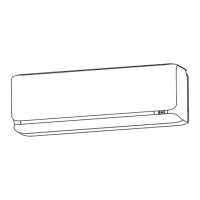
Do you have a question about the Mitsubishi Heavy Industries SRK35ZSX-S and is the answer not in the manual?
| Cooling Capacity | 3.5 kW |
|---|---|
| Heating Capacity | 4.0 kW |
| Power Supply | 220-240V, 50Hz |
| Energy Efficiency Class Cooling | A+++ |
| Refrigerant | R32 |
| Energy Efficiency Ratio (EER) | 3.5 |
| Noise Level (Indoor) | 43 dB(A) |
| Energy Efficiency Ratio (Cooling) | 3.5 |
| Energy Efficiency Ratio (Heating) | 4.0 |
| Noise Level (Outdoor Unit) | 50 dB(A) |
Covers safety symbols, warnings, and cautions for the proper and safe use of the air conditioner.
Safety guidelines for installing the unit to prevent potential hazards like electric shock or fire.
Essential safety measures and prohibitions during the normal use of the air conditioner.
Safety advice and procedures to follow when moving or servicing the air conditioner unit.
Advice for achieving economical and comfortable use of the air conditioner, including temperature and filter care.
Identifies and describes the various components of the indoor air conditioner unit.
Identifies and describes the various components of the outdoor air conditioner unit.
Explains the indicators, lights, and symbols displayed on the indoor unit.
Lists the various accessories that are included with the air conditioner unit.
Instructions for inserting and replacing batteries in the remote control.
Guidance on how to properly mount the remote control holder on a wall or pillar.
Important precautions and warnings for handling and using the remote control.
Troubleshooting steps for when the remote control malfunctions or fails to operate the unit.
How to operate the unit using the ON/OFF button when the remote control is unavailable.
Instructions on how to lock and unlock the remote control to prevent accidental operation.
Detailed explanation of the remote control's buttons, display, and operational functions.
Adjusting the left/right airflow direction range based on the unit's installation location.
How to adjust the vertical and horizontal airflow direction using the remote control.
Adjusting the motion sensor orientation to optimize detection of room occupancy.
Explanation of the motion sensor's functionality, application range, and limitations.
Automatic control of fan speed and airflow direction for efficient room air conditioning.
Modes for boosting cooling/heating performance (High Power) or saving energy (ECO).
Maintains a comfortable low temperature, approximately 10°C, during unattended periods.
Reduces the operational noise level of the outdoor unit for quieter performance.
Automatically stops the unit after a set time if no person is detected in the room.
Removes moisture from the indoor unit to prevent mold and bacteria growth.
Step-by-step guide to setting the current time and day of the week on the remote control.
How the unit automatically selects COOL or HEAT mode based on room temperature.
How to adjust the temperature settings when the unit is operating in AUTO mode.
Instructions for adjusting the fan speed to achieve desired comfort levels.
How to select and set the different operating modes available for the air conditioner.
Recommended and maximum/minimum operating temperature limits for optimal performance.
Details on how the heating mode functions, including capacity reduction and defrosting.
Setting the timer for the unit to automatically stop after a specified period.
Setting the timer for the unit to stop at a specific time.
Setting the timer for the unit to start operation at a specified time.
Using the Sleep Timer and On Timer functions simultaneously for combined control.
Using the On Timer and Off Timer functions simultaneously for combined control.
Setting up programmed operation schedules for each day of the week.
Detailed steps for setting individual timer programs for specific days of the week.
Steps for setting the same timer program for all days of the week simultaneously.
Procedures to cancel individual or collective weekly timer settings.
How to review and confirm the programmed weekly timer settings.
Overview of the menu function for accessing settings like brightness, auto-off, and self-clean.
Instructions for adjusting the brightness level of the unit's display screen.
Essential steps to take before performing any maintenance tasks on the unit.
Regular maintenance tasks to be performed during the period of unit operation.
Detailed instructions on how to remove and clean the air filters.
Guidance on cleaning the air inlet panel of the indoor unit.
Instructions on how to safely open and close the air inlet panel.
Steps for installing and replacing the air-cleaning filters, including allergen and deodorizing filters.
Recommendations for selecting an optimal and safe installation position for the unit.
Advice on professional inspection and routine maintenance for longevity and performance.
Common problems with the air conditioner and initial checks before contacting a service dealer.
Common observations related to airflow, such as no air blown or unusual airflow, and their causes.
Explanations for common sounds like gurgling, cracking, or whistling heard from the unit.
Various other operational observations, including restart issues, steam release, and smells.
Situations that require immediate contact with a dealer or qualified installer.
How the unit automatically resumes operation after a power interruption.
Guidelines and considerations for operating multiple air conditioner units simultaneously.
Interpreting error codes and abnormalities indicated by the unit's lights.
